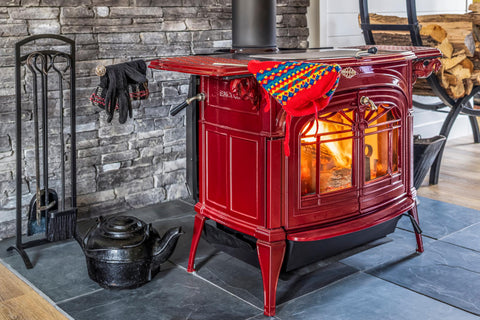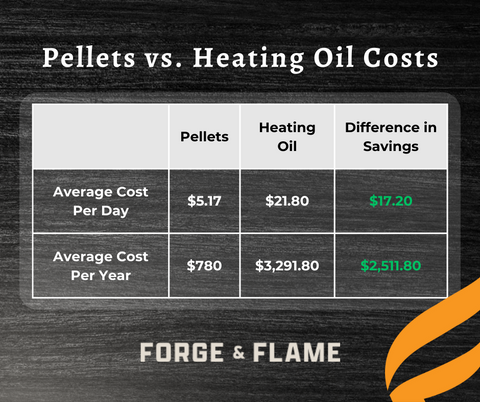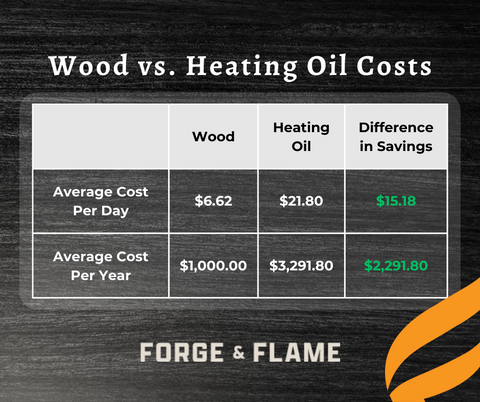In an era of economic uncertainty and soaring living expenses, the search for cost-effective alternatives becomes crucial. Enter pellet and wood stoves—alternative heating units that boast attributes such as user-friendly operation, heightened efficiency, accessibility of fuel and a commitment to sustainability, all while sparking a comforting ambiance.
Join us on a journey where the warmth sought is not just in the glow of flames but also in financial relief and sustainable choices that resonate throughout our homes. Let's discover together how to save money with alternative home heating, creating spaces that are economically resilient and environmentally responsible.
What is a Heating Stove?
Heating stoves, versatile and efficient, function as standalone units designed to generate heat by burning various fuels such as wood, pellets or gas. These freestanding appliances provide a distinct and concentrated source of warmth, making them particularly valuable in residential spaces. Essential to their operation is proper venting, ensuring the safe expulsion of combustion byproducts.
Like heating stoves, fireplace inserts serve as a seamless retrofit solution. Designed to slide into existing fireplace spaces, these inserts leverage the ambiance of a traditional hearth while enhancing heating efficiency.
With their diverse fuel options and adaptability to different living environments, heating stoves stand as reliable and customizable solutions for achieving both comfort and energy efficiency in a home.
Benefits of Heating Stoves

Discover the myriad advantages that heating stoves bring to your home. Heating stoves bring more than just warmth, they serve as the ultimate solution for issues homeowners care about most:
- Cost savings
- Efficiency
- Sustainability
- Reliability
- Ambiance
- Ease of use
- Local and federal incentives and tax credits
How Heating Stoves Save Money
Heating stoves stand as cost-friendly champions in the realm of home heating. One of the primary contributors to their cost-saving allure is the utilization of low-cost, renewable fuels. Whether opting for pellets or wood, these heating stoves tap into eco-friendly resources, offering not just warmth but also a conscientious nod to sustainability.
Stable Fuel Costs
When it comes to stability in heating costs, heating stoves excel. The benefit of heating stoves is not simply a matter of immediate savings, but also the long-term financial stability they offer. The low-cost, renewable nature of their fuel sources ensures a consistent and economical supply, shielding users from the volatility often associated with traditional energy markets. Buying in bulk, a practice encouraged by the nature of heating stoves, not only provides convenience but also often comes with discounted rates, accentuating the financial savviness of purchasing these systems.
High-Efficiency Units
The high efficiency of heating stoves is a key benefit in their money-saving prowess. Adhering to stringent EPA standards, these stoves optimize fuel consumption, translating into more heat for your buck. With advancements in key technologies, such as advanced combustion systems and programmable thermostats, users can exercise precise control over their heating requirements, minimizing waste and maximizing efficiency.
Forge & Flame’s Key Technologies
Not all stoves are made the same. With innovative engineering, Forge & Flame’s units optimize the way you heat. Explore the host of technologies that make our brands stand out among the rest:
How Much Can a Heating Stove Save on Costs?
When it comes to savings, math speaks for itself. Take these scenarios as examples:
Heating Oil vs. a Pellet Stove

Say you live in a 2,000-square-foot home in New Jersey paying $4.36/gallon for oil. If you purchase a pellet stove that is eligible for the tax credit — which covers a percentage of purchase and installation costs — you will get 30% back on the following year’s tax return. So, if you were to buy a Harman P43 pellet stove this year at $4,079 plus $1,000 for the vent pipe and installation, and $400 hearth pad for a total of $5,479, you’ll get $1,643 back once you complete your tax return next year.
On average, the typical pellet stove owner uses three tons of pellets to heat their home per year at a cost of $260.00 per ton, totaling approximately $780 in fuel costs per year.
In comparison, an average homeowner in the Northeast United States uses five to eight gallons of heating oil, totaling between $21.80-$34.88 per day. If you are heating your home from November to March, those 151 days add up quickly — totaling between $3,291.80 to $5,266.88 per year.

On the low end of that cost breakdown, $3,291.80 (cost per heating oil per year) minus $780.00 (cost per heating pellets per year) is a savings of $2,511! Remember, with the cost of the unit and installation after the federal biomass tax credit, you have invested $3,836, which means in less than two years of use, switching to pellets pays for itself. Moreover, with proper care and maintenance, pellet stoves can last between 10 to 15 years.
Heating Oil vs. a Wood Stove

Likewise, wood stoves prove to be a sound economical choice over heating oil. If the same homeowner in New Jersey opted for a wood stove to heat their 2,000 square-foot home and purchased a tax-credit qualifying Vermont Castings Encore wood stove at $3,789.00, plus installation and hearth pad costs of $3,250, the initial investment would total around $7,039. Since this unit qualifies for the 30% biomass tax credit, capped at $2,000, $2,000 would be deducted from your tax return the following year.
As for fuel requirements, a good rule of thumb to follow is two to three cords for every 1,000 square feet per season. In this example, with a home of 2,000 square feet, four to six cords would be needed to last one winter. Many factors go into the cost of wood — such as if you chop your own or go through a supplier — so this calculation may vary. However, you can purchase four cords of wood in New Jersey on average for $1,000 or $1,500 for six.

So, if you are using heating oil that may cost around $3,291.80 on the low end, opting for wood fuel using four cords of wood at $1,000 will add up to a total yearly savings of $2,291.80. With the tax credit deducted from your initial investment, switching to wood would initially cost $5,039, meaning in less than three years of use, your wood stove would have paid off its initial investment and more! Keep in mind, with proper use and maintenance wood stoves can last between 10 to 15 years. It pays to be sustainable!
Switch and Save with a Heating Stove
Heating stoves emerge as astute financial choices, combining sustainability and efficiency with cost-effectiveness. Whether fueled by pellets sourced locally or wood from your own backyard, the economic benefits extend beyond immediate savings. The stable costs, coupled with the ability to buy in bulk, position heating stoves as wise investments in both economic and environmental terms. As we navigate a period of financial uncertainty, the choice to embrace heating stoves is not just a commitment to warmth but a strategic move towards financial resilience and environmental responsibility.
For more information on cost savings, please visit a local Forge & Flame dealer or explore tax credit-qualifying units online.


